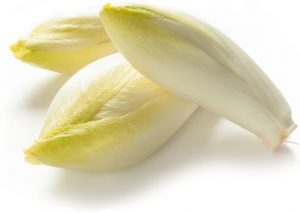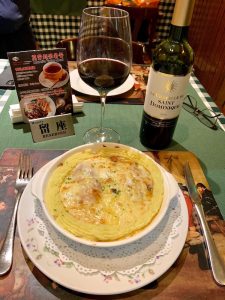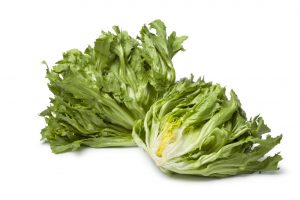The confusion about witloof/chicon
The vegetable that we call witloof or chicon or endive is mostly translated in English as “endive”. The translation is misleading. In Belgium we call it witloof in Dutch and chicon in French.
 The correct defintion:
The correct defintion:
A variety of the common chicory (Cichorium intybus var. foliosum) cultivated to produce a narrow, pointed, blanched cluster of leaves used in salads.
Chicon is the name given to a type of endive. Bitter-tasting and white with yellow edges, this type of chicory can be eaten raw or cooked.
Also called Belgian endive, witloof, witlof, chicon, witloof chicory, Brussels witloof.
For me the signature dish of Morel’s Restaurant is this one:
 Simply de-li-cious. But better be hungry to finish it!
Simply de-li-cious. But better be hungry to finish it!
Called “chicon au gratin” it is in fact “witloof in hespenrolletjes” (https://www.lekkervanbijons.be/recepten/witloofrolletjes-met-gekookte-ham) – a very popular and traditional Flemish dish – is also called endive and ham gratin, endive with ham and cheese sauce or chicon gratin.
And another description:
Chicons au gratin is a Belgian national dish consisting of braised Belgian endives (aka chicons) wrapped in slices of baked ham and covered with a Mornay sauce and some grated cheese. Steaming hot with a creamy cheesy sauce, chicons au gratin is comfort food par excellence. The bitter Belgian endives mixed with the sweet baked ham also make a winning combination.
andijvie (endive lettuce)
In Belgium and Holland we do have a vegetable that we call “andijvie”; it is a a plant (Cichorium endivia) in the composite family, of South Asian origin, having curled or ruffled leaves with a bitter flavor, cultivated as a salad green. It is closely related to “witloof”.
It is used as a salad or cooked in a few local dishes, or mixed raw in Dutch potato dishes (“stamppot”).
 See here the explanation in Dutch and different recipes to prepare “andijvie”, more on the original website:
See here the explanation in Dutch and different recipes to prepare “andijvie”, more on the original website:
https://dejuistekooktijd.nl/groente/andijvie-koken-en-bereiden/
Andijvie is een typisch Nederlandse bladgroente met een licht bittere smaak. De groente is nauw verwant aan witloof en wordt in de Hollandse keuken vaak gebruikt in stamppotten. Je kan echter nog veel meer kanten met deze groente op. Zo is andijvie ook populair in verschillende diëten. Dit komt vooral doordat er zeer weinig calorieën in de groente zitten, maar wel zeer veel vitaminen en mineralen.
Je kan andijvie bereiden door deze te koken, in de oven klaar te maken, te roerbakken / wokken en nog tal van andere manieren. De groente kan je naast bereiden ook perfect rauw eten. Andijvie is dan ook heerlijk om te gebruiken in een mooie ovenschotel, salade, andijviesoep of in de stamppot (rauw of gekookt).
Zoals gezegd hoef je andijvie niet per se te bereiden, je kan de groente ook perfect rauw eten. De groente is dan ook ideaal om een snelle salade mee te maken of een stamppot rauw andijvie.
Gilbert, did you ever hear about groenlof? It’s also called ‘suikerbrood’. Here the farmers say the flavour is in between endive and witlof 😉
Latin name is Cichorium intybus var. foliosum.
Greetings from Belgium